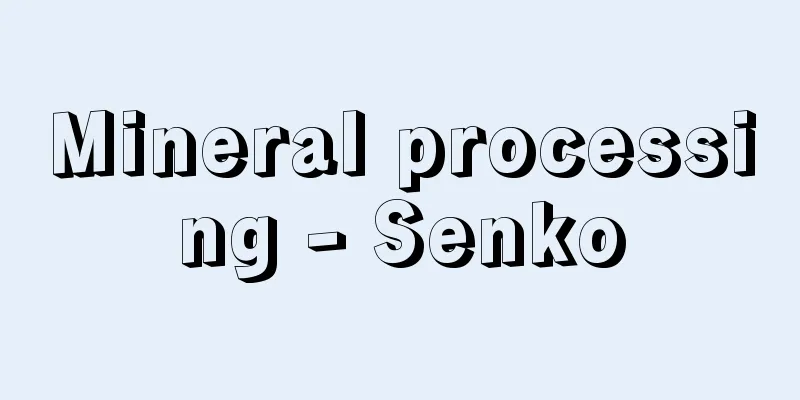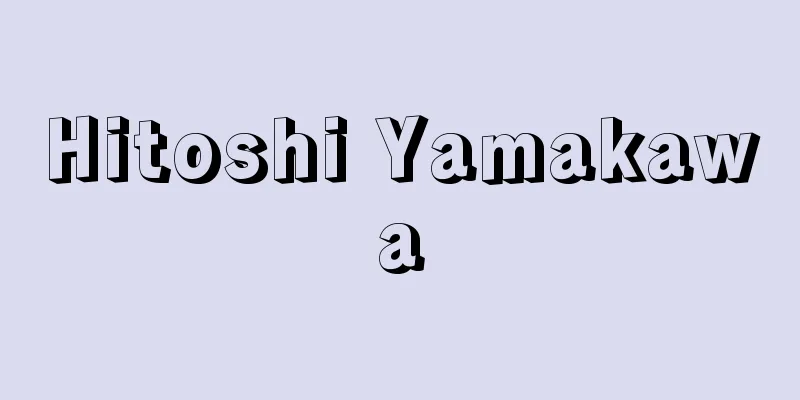Mineral processing - Senko

|
Processing ores that are composed of several minerals, and separating the useful minerals from the unusable ones by physical means. When there are two or more useful minerals, this also includes separating them from each other. In a broad sense, it refers to all processing techniques that include sorting and separation. In the case of coal sorting, it is specifically called coal washing. Ores (raw ore ore) extracted from mines as they are contain a lot of useless minerals, namely host rock (rocks surrounding the deposit) and gangue (worthless minerals within the deposit), in addition to the desired useful minerals, and are usually not usable as is. For example, in the case of copper ore, the raw ore grade is around 1% copper and only a few percent copper mineral, and smelting such low-grade ore as it is to extract metallic copper is costly and economically unprofitable. Therefore, it is necessary to increase the grade of useful minerals through inexpensive dressing processes and separate and remove large amounts of useless minerals. [Kinjiro Aso] Types of mineral processingThe main focus of mineral processing technology is sorting and separation, which is a method of physically separating minerals by utilizing the differences in physical or physicochemical properties of minerals. [Kinjiro Aso] Hand-selectedThe oldest method of mineral sorting is hand sorting, in which minerals are sorted by hand by visually distinguishing differences in color, luster, shape, etc., but this method is rarely used today due to rising labor costs and the decline in the quality of ores. Color sorting machines are a mechanized version of hand sorting, and are still in use in some areas. [Kinjiro Aso] Gravity sortingGravity separation makes use of the difference in density (specific gravity) of minerals, and initially it was an empirical application of the difference in the movement of mineral particles in a horizontal water flow, starting with the down-flow method and evolving into the shaking table. The jig was invented by placing the ore in a sieve and shaking it up and down in the water to collect the heavy mineral particles at the bottom. Dense liquid separation was the latest to be developed in the field of comparative separation, and it is interesting that this theoretically simple and excellent method based on Archimedes' principle was the last to be developed. [Kinjiro Aso] Magnetic sortingMagnetic separation, which uses magnets to separate strongly magnetic minerals such as magnetite, has been used for a long time, but in recent years, a method called high gradient magnetic separation has become available, which uses a high magnetic field gradient on top of a strong magnetic field to separate weakly magnetic paramagnetic minerals. Electrostatic separation, which uses the difference in electrical conductivity of minerals, has a small processing capacity and is used in special cases. [Kinjiro Aso] FlotationCurrently, the main method of mineral selection is flotation, which uses various chemicals (flotation agents) to adjust the surface properties of minerals and utilize the differences in affinity between minerals for water or air. It was first used to select metallic sulfide minerals, but its range of application has since expanded to include non-metallic minerals such as oxide minerals and silicate minerals, and more recently it has even been used to separate and remove heavy metal ions from aqueous solutions. Other factors that are used for sorting include radioactivity, particle shape, and friability. Although different in nature from the sorting methods mentioned above, the size of particles can determine the quality of some products. For example, with coal, gravel, and crushed stone, sieving and classification, which are methods for separating particles by size, are used as a type of sorting method. [Kinjiro Aso] Basic operations for sortingWhen separating by physical operations, each particle must consist of a single mineral, and this state is called liberation. Particles consisting of a single mineral are called single-edged particles, and particles in which useful and unnecessary minerals are attached are called single-edged particles. Most ores extracted from mines are single-edged, and must be liberated before sorting. To achieve this, the raw ore is crushed and pulverized. In the past, high-grade deposits were mined, so relatively coarse crushing was sufficient for liberation, and a sorting method appropriate to the size (for example, gravity sorting) was used. Today's non-ferrous metal deposits are low-grade, and liberation is insufficient unless the ores are finely crushed. Fortunately, flotation has made it easier to separate fine powders, but in any case, liberation is a necessary condition as a preliminary step to sorting and separation. Although sorting can be done dry, such as magnetic separation for coarse particles, wet methods are usually used when the particles are fine. For example, in the case of flotation, sorting is done when the ore powder is suspended in water (ore solution or pulp). For this reason, the pre-sorting process of crushing for free radical separation is also wet, which necessitates wet classification (a method of separating particles by size using differences in sedimentation speed in water). The product of sorting and separation is also pulp-like, and unit operations such as concentration and filtration to extract solid mineral particles from this are also included in the broad definition of mineral dressing technology. Next, we will discuss the flotation of metal ores as an example of mineral dressing that combines the various unit operations mentioned above. [Kinjiro Aso] Metal ore flotation systemsThe mined ore is stored in the mine storage shed by face (ore mining site) or grade. In ore dressing, it is important that the raw ore grade is uniform, so a specified ratio of ore is extracted from each storage shed and transported to the dressing plant. The dressing system is roughly divided into two stages, a front and a back. The front stage is the receiving and crushing system, where the raw ore is received and then crushed in two stages, coarsely and mediumly, and the raw ore up to several tens of centimeters in size is crushed to about 10 mm or less and stored in a powder ore bin. This system is usually only operated in the daytime in the first stage due to the work inside the mine, and the storage bin adjusts this in relation to the three-way continuous 24-hour operation of the latter stages of crushing and flotation. For crushing, a gyratory crusher or jaw crusher is used for coarse crushing, and a cone crusher is used for medium crushing. In addition, a combination of sieves is used to remove fine particles that do not need to be crushed at each stage. Depending on the nature of the raw ore, unnecessary minerals and rocks that are freed at this stage may be removed by heavy sorting. In addition, if the raw ore contains fine particles (primary slime) that have a negative effect on flotation, a classification device is installed to remove them. The rest of the process from the fines bin is crushing, flotation and product processing. Crushing is carried out in a wet closed loop in combination with classification, usually using a ball mill as the crusher and a spiral or wet cyclone as the classifier. The crushed particle size varies depending on the nature of the ore, but can be up to about 200 micrometers. The purpose of crushing is liberation, but grinding too finely can have a negative effect on flotation. After crushing, the pulp is sent to a conditioning tank where a collector is added. The collector reacts with the target minerals to make their surfaces hydrophobic (resistant to water). The pulp is then sent to a flotation machine where it is thoroughly agitated and air is introduced. The air turns into fine bubbles due to the action of the added foaming agent and the agitation, and collides with the mineral particles in the pulp. At this time, the hydrophobic mineral particles adhere to the bubbles, but the minerals not affected by the collector are hydrophilic and do not adhere to the bubbles and remain in the water. The air bubbles rise to the surface with the attached mineral particles, creating a layer of foam (froth) on the surface of the pulp, which overflows or is scraped out to become the concentrate. If there are two or more types of target metallic minerals, an inhibitor is used to prevent one mineral from reacting with the collector and separate it from the other minerals. An activator is used to make the inhibited minerals react with the collector again. There are various types of flotation machines, but the type most commonly used today is the mechanical agitation/air introduction type, and the required number of machines are lined up in series and operated according to the required flotation time. The concentrate extracted by flotation is still in a pulp-like form, and in order to separate the water, it is first thickened in a thickener, and then dewatered in a filter to produce the product. The tailings (waste rock) remaining after the concentrate is extracted is also in a pulp-like form, and after thickening, it is dumped into a tailings dam for disposal. In recent years, it has become difficult to acquire land for dams, and as a method of processing and disposing of tailings, in addition to filling up the mine shafts after the mine has been excavated, research is being conducted into its effective use. For separation methods other than flotation, the process is the same, starting with crushing, grinding, and sorting for liberation, followed by product processing. Ore dressing technology was developed for the separation of minerals, but today it is used for the separation and treatment of solid waste and various types of wastewater, contributing to the recycling of resources and environmental conservation. [Kinjiro Aso] [Reference] | | washing| |Source: Shogakukan Encyclopedia Nipponica About Encyclopedia Nipponica Information | Legend |
|
いくつかの鉱物から構成されている鉱石を処理して、そのなかの有用鉱物と不用の鉱物とを物理的手段で選別、分離すること。有用鉱物が2種類以上ある場合は、これらを互いに分離することも含む。広義にはこの選別、分離を含む処理技術全部をいう。石炭の選別の場合、とくに選炭という。 鉱山より採掘されたままの鉱石(原鉱または粗鉱)中には、目的とする有用鉱物以外に、不用鉱物すなわち母岩(鉱床周囲の岩石)および脈石(みゃくせき)(鉱床内の無価値の鉱物)を多く含み、そのままでは利用できないのが普通である。たとえば銅鉱石の場合、原鉱品位が銅として1%前後、銅鉱物としても数%ぐらいで、このような低品位の鉱石をそのまま製錬して金属銅を採取するのでは、費用がかかり経済的に採算がとれない。したがって費用の少ない選鉱作業によって有用鉱物の品位を高め、大量の不用鉱物を選別除去することが必要となる。 [麻生欣次郎] 選鉱法の種類選鉱技術の主体は選別、分離である。これは鉱物によって物理的あるいは物理化学的性質の差があることを利用して、物理的に鉱物の選別を行うものである。 [麻生欣次郎] 手選もっとも古い選鉱法は手選(てせん)で、鉱物の色、光沢、形などの違いを目で判別し、手で選別する方法であるが、現在では人件費の高騰、鉱石の低品位化などでほとんど行われていない。手選を機械化したものに色彩選鉱機があり、一部用いられている。 [麻生欣次郎] 比重選別鉱物の密度(比重)の差を利用したものが比重選別(比選)であり、最初は水平水流中の鉱物粒子の運動の差を経験的に応用したもので、樋(とい)流し法から始まってシェーキングテーブルshaking tableへと発達した。また、ざるの中へ鉱石を入れて水中で上下に揺り動かし、比重の大きな鉱物粒子を下層に集めることからジグjigが生まれた。比選でもっとも遅れて開発されたのは重液選別(重選)であるが、アルキメデスの原理に基づく理論的に簡単で優れた方法が最後になったのは興味深い。 [麻生欣次郎] 磁力選別磁鉄鉱などの強磁性鉱物を磁石で選別する磁力選別(磁選)も古くから行われた方法であるが、最近では高勾配(こうばい)磁選と称して、強い磁場の上に高い磁場勾配により磁性の弱い常磁性鉱物の選別も可能になってきた。鉱物の電気伝導度の差を利用する静電選別は、処理能力が小さく、特殊の場合に使用される。 [麻生欣次郎] 浮遊選別現在、選鉱の主力は浮遊選別(浮選)で、種々の薬剤(浮選剤)を用いて鉱物の表面性質を調整し、その鉱物間の水または空気に対する親和性の差を利用したものである。初め金属硫化鉱物の選別に用いられたが、その後、酸化鉱物、珪酸塩(けいさんえん)鉱物など非金属鉱物にも適用範囲が広がり、さらに最近では水溶液中の重金属イオンの分離除去にまで応用されている。 このほか、放射能、粒子の形状、破砕性なども選別に利用される。以上述べた選別とは性質が異なるが、商品によっては粒子の大きさがその品質を規定する場合がある。たとえば石炭、砂利、砕石などで、この場合篩(ふるい)分け、分級という分粒操作(大きさ別に分ける方法)が一種の選別法として用いられる。 [麻生欣次郎] 選別の基本操作物理的操作で選別分離を行う場合、各粒子がそれぞれ別の単一鉱物から成り立っていることが必要であり、この状態を単体分離という。単一鉱物からなる粒子を単体粒子、有用鉱物と不用鉱物がくっついている粒子を片刃(かたは)粒子という。鉱山から採掘されたままの鉱石は片刃状のものが大部分で、選別する前に単体分離の状態にせねばならない。このためには原鉱を破砕、粉砕する。昔は高品位の鉱床を採掘していたので比較的粗く砕いても、十分単体分離されており、その大きさに適した選別法(たとえば比重選別)が用いられていた。現在の非鉄金属鉱床は低品位で、細かく微粉砕しないと単体分離が十分ではない。さいわい浮選によって微粉の選別が容易になったが、いずれにしても選別分離の前段階として単体分離が必要条件となる。 選別は粗粒の場合の磁選など乾式でなされることもあるが、粒子が微細になると湿式で行うのが普通である。たとえば浮選の場合、鉱石粉末を水に懸濁させた状態(鉱液またはパルプ)で選別を行う。このため選別の前処理である単体分離のための粉砕も湿式であり、これに伴って湿式分級(水中での沈降速度の差を利用して粒子の大きさ別に分ける方法)が必要となる。また、選別分離後の産物もパルプ状であり、この中から固体の鉱物粒子を取り出すための濃縮、濾過(ろか)などの単位操作も広義の選鉱技術に含まれる。次に、以上に述べた各種の単位操作を組み合わせた選鉱の例を金属鉱石の浮選について述べる。 [麻生欣次郎] 金属鉱石の浮選系統採掘された鉱石は坑内貯鉱舎に切羽(きりは)(鉱石の採掘場)別または品位別に蓄えられる。選鉱では原鉱品位が均一であることがたいせつで、これを考慮して各貯鉱舎より所定の割合で鉱石を抜き出し、選鉱場へ運搬する。選鉱系統は大別して前後二段に分かれる。前段が受入れ、破砕の系統で、原鉱を受け入れたのち、通常、粗砕、中砕の二段破砕を行い、最大数十センチメートルの原鉱を約10ミリメートル以下に破砕して粉鉱ビンに貯鉱する。この系統は坑内作業との関係で普通昼間の一番方のみの操業で、後段の粉砕、浮選の三方連続24時間操業との関連で貯鉱ビンがこれを調節している。破砕には粗砕用としてジャイレートリークラッシャーgyratory crusherまたはジョークラッシャーjaw crusherが、中砕用にコーンクラッシャーcone crusherが使用される。なお、それぞれの段階で砕く必要のない細かい粒子をあらかじめ除くため、篩を組み合わせて用いる。原鉱の性質によっては、この時点で単体分離される不用の鉱物、岩石を重選で除去することもある。また、原鉱中に浮選に悪影響を与える微粒子(一次スライム)を含む場合は、これを除去する分級装置が組み込まれる。 粉鉱ビンから後の系統は粉砕、浮選および産物処理である。粉砕は分級と組み合わせて湿式閉回路で行われ、粉砕機にはボールミルball mill、分級機にスパイラル型または湿式サイクロンwet cycloneが用いられるのが普通である。粉砕粒子径は鉱石の性質により異なるが、最大約200マイクロメートルである。粉砕の目的は単体分離であるが、あまり微細に砕きすぎると浮選に悪影響がある。 粉砕後パルプは条件槽に送られ、ここで捕収剤が添加される。捕収剤は目的とする鉱物と反応してその表面を疎水性(水にぬれにくい性質)にする。ついでパルプは浮選機に送り込まれ、十分攪拌(かくはん)されると同時に空気が導入される。空気は添加された起泡剤の働きと攪拌作用によって細かい気泡となり、パルプ中の鉱粒と衝突する。このとき、疎水性の鉱粒は気泡に付着するが、捕収剤の作用していない鉱物は親水性で気泡に付着せず水中にとどまる。気泡は付着した鉱粒とともに浮上して、パルプの表面に泡の層(フロスfroth)をつくり、溢流(いつりゅう)するか、または掻(か)き出されて精鉱となる。目的とする金属鉱物が2種類以上ある場合は、抑制剤を用いて一方の鉱物が捕収剤と作用しないようにして他の鉱物と分離する。一度抑制された鉱物をふたたび捕収剤と作用させるには活性剤を用いる。 浮選機にはいろいろの型があるが、現在もっとも多く使用されているのは、機械攪拌・空気導入型のもので、必要とする浮選時間に応じて所要台数を直列に並べて操業する。 浮選で採取された精鉱はなおパルプ状であり、水を分離するため、まずシックナーthickener(濃縮機)で濃縮し、ついでフィルター(濾過機)で脱水されて製品となる。精鉱をとった残りの尾鉱(廃石)もパルプ状であり、濃縮のうえ廃滓(はいさい)ダムへ流送廃棄される。近年、ダム用地の取得が困難となり、廃滓の処理、処分法として、採掘跡の坑内充填(じゅうてん)のほか、その有効利用が研究されている。 浮選以外の選別法の場合もその系統は同じで、まず単体分離のための破砕、粉砕、そして選別、産物処理となる。 選鉱技術は鉱物の選別に対して発展したものであるが、現在ではこの技術が、固形廃棄物の選別処理、各種廃水の処理に用いられており、資源のリサイクルrecycle、環境保全に役だっている。 [麻生欣次郎] [参照項目] | | | |出典 小学館 日本大百科全書(ニッポニカ)日本大百科全書(ニッポニカ)について 情報 | 凡例 |
>>: Gradual enlightenment - Zengo
Recommend
Gheorghe Asachi
1788‐1869 The founder of modern education in Moldo...
Three things not to go, seven things to come out - Sanfukyōshichishūtsu (English)
In old China, there were seven reasons for divorci...
Bregma
…The central point of the upper edge of the exter...
Umbilical cord - Saitaikenraku (English spelling) Nuchal cord
What is the disease? Umbilical cord entanglement ...
Texas [State] - Texas
A state on the Gulf Coast of the United States. Ab...
Helicoverpa armigera (English spelling) Helicoverpa armigera
…[Shigeo Sugi]. … *Some of the terminology that r...
Evil Shichibei Kagekiyo
A play by Hirosue Tamotsu. It premiered at the But...
Sankuro Mitani
The names of wealthy merchants from the Edo period...
ESCB - ESCB
Please see the European Central Bank page. Source...
Thecosmilia
…In Japan, they are known from various geological...
Spirobranchus giganteus corniculatus
It is a member of the phylum Annelida, class Polyc...
Odontoglossum rossii - Odontoglossum rossii
...They were introduced to Japan around the end o...
Smendes
...Only mercenaries and priests grew in power, an...
Hard water - Kousui (English spelling)
Natural water that contains relatively large amou...
《Osan Mohee》 - Osan Mohee
...A domestic drama. Commonly known as "Osan...









